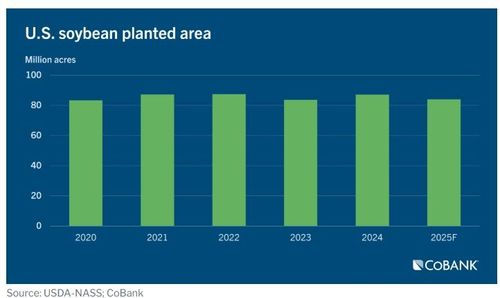CoBank predicts 3.6% decline in planted soybean acreage for 2025

SOURCE: CoBank
February 25, 2025
BY Erin Voegele
CoBank is predicting soybean planted acreage for 2025 will decline by 3.6% this year, falling to 84 million acres, according to the company’s spring acreage outlook report, which was released Feb. 20.
If realized, the 84 million acres of soybeans currently expected to be planted for 2025 will be down when compared to the 87.1 million in planted acreage reported for 2024, but up slightly from the 83.6 million acres of soybeans planted in 2023.
While soybeans are expected to experience the biggest low of acreage nationwide, CoBank said the loss will be somewhat blunted by last fall’s expansion of winter wheat acres that will create more opportunity for farmers to double-crop soybeans behind the winter wheat harvest.
Advertisement
Within the report, CoBank stresses that the planting season is still weeks away, meaning the acreage balance is still in flux. Multiple factors could impact planting decisions. For soybeans, those factors include tariffs on imports of used cooking oil from China and potential tariffs on Canadian canola oil, which would lift demand for soybean oil and encourage farmers to hold on to soybean acres.
A full copy of the report is available on the CoBank website.
Advertisement
Related Stories
The U.S. EPA on July 8 hosted virtual public hearing to gather input on the agency’s recently released proposed rule to set 2026 and 2027 RFS RVOs. Members of the biofuel industry were among those to offer testimony during the event.
The USDA’s Risk Management Agency is implementing multiple changes to the Camelina pilot insurance program for the 2026 and succeeding crop years. The changes will expand coverage options and provide greater flexibility for producers.
The USDA’s National Agricultural Statistics Service on June 30 released its annual Acreage report, estimating that 83.4 million acres of soybeans have been planted in the U.S. this year, down 4% when compared to 2024.
SAF Magazine and the Commercial Aviation Alternative Fuels Initiative announced the preliminary agenda for the North American SAF Conference and Expo, being held Sept. 22-24 at the Minneapolis Convention Center in Minneapolis, Minnesota.
Scientists at ORNL have developed a first-ever method of detecting ribonucleic acid, or RNA, inside plant cells using a technique that results in a visible fluorescent signal. The technology could help develop hardier bioenergy and food crops.
Upcoming Events










